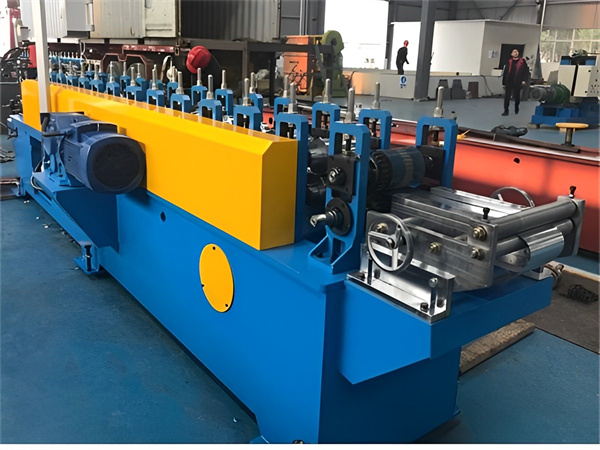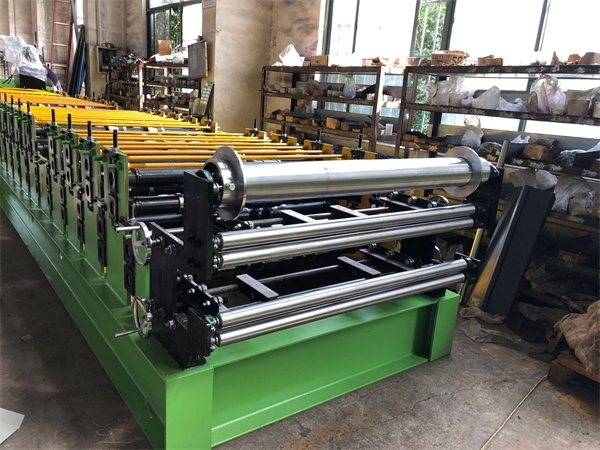1. Pendahuluan
Dalam dunia konstruksi dan manufaktur yang terus berkembang, permintaan akan solusi atap yang efisien, hemat biaya, dan berkualitas tinggi terus meningkat. Komponen penting dalam produksi genteng baja adalah Mesin Roll Forming Genteng Baja. Keajaiban teknik ini telah mengubah cara pembuatan ubin baja, menawarkan banyak keuntungan dibandingkan metode tradisional.
2. Apa itu Mesin Roll Forming Genteng Baja?
SEBUAH Mesin Roll Forming Genteng Baja adalah peralatan khusus yang digunakan dalam industri pengerjaan logam untuk membentuk gulungan logam datar menjadi profil dan pola tertentu. Dalam konteks atap, mesin ini dirancang untuk memproduksi genteng baja dengan dimensi yang konsisten dan desain yang rumit. Prosesnya melibatkan pembengkokan strip logam secara terus menerus melalui serangkaian rol untuk mencapai bentuk yang diinginkan.
3. Prinsip Kerja Mesin Roll Forming Genteng Baja
Pengoperasian Mesin Roll Forming Genteng Baja didasarkan pada prinsip yang sederhana namun efektif. Mesin menerima lembaran logam melingkar sebagai masukan dan melewatkannya melalui set rol berkontur. Rol ini secara progresif membentuk logam menjadi profil ubin yang dibutuhkan. Prosesnya sangat otomatis dan dapat menghasilkan ubin baja dalam jumlah besar dalam waktu singkat.

4. Keuntungan Menggunakan Mesin Roll Forming Genteng Baja
- Efektivitas Biaya: Sifat otomatis mesin ini mengurangi biaya tenaga kerja dan meningkatkan efisiensi produksi secara keseluruhan, sehingga menjadikannya solusi yang hemat biaya untuk produksi ubin skala besar.
- Presisi dan Konsistensi: Penggunaan sistem yang dikendalikan komputer memastikan bahwa setiap ubin yang diproduksi memiliki bentuk, ukuran, dan desain yang seragam, sehingga meminimalkan pemborosan.
- Keserbagunaan: Mesin Roll Forming Genteng Baja dapat membuat berbagai macam profil ubin, memungkinkan produsen untuk memenuhi preferensi pelanggan yang beragam.
- Kecepatan: Kemampuan produksi berkecepatan tinggi dari mesin ini memastikan pemenuhan pesanan yang cepat dan waktu tunggu yang lebih singkat.
- Daya tahan: Ubin baja yang diproduksi dengan metode ini menunjukkan kekuatan dan daya tahan yang sangat baik, menawarkan perlindungan yang dapat diandalkan untuk bangunan.
- Kustomisasi: Produsen dapat dengan mudah menyesuaikan desain ubin sesuai kebutuhan pelanggan, memberikan mereka keunggulan kompetitif di pasar.
5. Jenis Mesin Roll Forming Genteng Baja
Ada beberapa jenis Mesin Roll Forming Genteng Baja yang tersedia di pasaran, masing-masing melayani tujuan tertentu:
5.1 Mesin Roll Forming Genteng Baja Lapis Tunggal
Jenis mesin ini dirancang untuk memproduksi ubin baja lapis tunggal, yang memiliki desain sederhana namun sangat efektif dalam melindungi bangunan dari berbagai elemen.
5.2 Mesin Roll Forming Genteng Baja Lapis Ganda
Mesin lapisan ganda memungkinkan produksi dua profil ubin yang berbeda secara bersamaan, menawarkan fleksibilitas yang lebih besar bagi produsen.
5.3 Mesin Roll Forming Genteng Baja Mengkilap
Ubin baja mengkilap dilapisi dengan lapisan pelindung, memberikan ketahanan tambahan terhadap pelapukan dan meningkatkan estetika.
6. Komponen Mesin Roll Forming Genteng Baja
Mesin Roll Forming Genteng Baja terdiri dari beberapa komponen penting yang bekerja sama untuk menciptakan produk akhir:
6.1 Decoiler
Decoiler bertanggung jawab untuk menahan dan melepaskan lembaran logam yang digulung, memastikan pasokan bahan baku yang berkelanjutan ke mesin.
6.2 Sistem Pemberian Makan
Sistem pengumpanan memandu strip logam melalui unit pembentuk gulungan, mempertahankan keselarasan dan tegangan yang tepat.
6.3 Unit Pembentuk Gulungan
Jantung dari mesin ini, yaitu unit pembentuk gulungan, terdiri dari serangkaian rol yang membentuk logam menjadi profil ubin yang diinginkan.
6.4 Sistem Pemotongan
Sistem pemotongan bertanggung jawab untuk secara akurat memotong profil ubin kontinu menjadi ubin individu dengan panjang yang dibutuhkan.
6.5 Sistem Kontrol PLC
Pengontrol logika yang dapat diprogram (PLC) mengontrol dan menyinkronkan berbagai komponen alat berat, memastikan proses produksi yang lancar dan efisien.

7. Bagaimana Cara Mengoperasikan Mesin Roll Forming Genteng Baja?
Mengoperasikan Mesin Roll Forming Genteng Baja mungkin tampak rumit, tetapi dengan panduan yang tepat, ini menjadi proses yang mudah. Berikut adalah panduan langkah demi langkah:
7.1 Langkah 1: Menyiapkan Bahan Baku
Mulailah dengan memastikan bahwa gulungan logam sesuai dengan spesifikasi yang diperlukan untuk profil ubin yang diinginkan. Muatkan gulungan ke dalam decoiler.
7.2 Langkah 2: Menyiapkan Mesin
Sesuaikan rol dan sistem pemotongan sesuai dengan profil ubin tertentu. Periksa sistem pengumpanan untuk memastikan aliran material yang lancar.
7.3 Langkah 3: Memulai Proses Roll Forming
Nyalakan mesin dan mulai proses pembentukan gulungan. Strip logam akan melewati rol, mengambil bentuk profil ubin.
7.4 Langkah 4: Memotong dan Menumpuk
Saat profil ubin kontinu keluar dari unit pembentuk gulungan, sistem pemotongan akan memotongnya secara akurat menjadi ubin individual. Kumpulkan ubin dalam unit penumpukan.
7.5 Langkah 5: Inspeksi dan Pengemasan
Periksa ubin untuk mengetahui adanya cacat atau ketidaksempurnaan. Setelah disetujui, kemas ubin dengan aman untuk disimpan atau diangkut.
8. Perawatan dan Pemecahan Masalah Mesin Roll Forming Genteng Baja
Merawat Mesin Roll Forming Genteng Baja sangat penting untuk kinerja optimal dan umur panjang. Selain itu, memahami masalah umum dan solusinya sangat penting untuk produksi tanpa gangguan.
8.1 Tips Perawatan Rutin
- Pelumasan: Lumasi komponen yang bergerak secara teratur untuk mengurangi gesekan dan keausan.
- Inspeksi: Lakukan pemeriksaan rutin untuk mengidentifikasi tanda-tanda keausan atau kerusakan.
- Pembersihan: Jaga agar mesin tetap bersih dan bebas dari serpihan untuk mencegah kemacetan dan kerusakan.
8.2 Masalah Umum dan Solusi
- Profil Ubin yang Tidak Rata: Periksa dan sesuaikan rol untuk memastikan pembentukan strip logam yang rata.
- Gangguan Material: Periksa sistem pengumpanan dan unit pemotongan untuk mencari penghalang dan bersihkan.
9. Tindakan Pencegahan Keselamatan Saat Menggunakan Mesin Roll Forming Genteng Baja
Keselamatan harus menjadi prioritas utama saat mengoperasikan Mesin Roll Forming Genteng Baja untuk mencegah kecelakaan dan cedera. Berikut adalah beberapa tindakan pencegahan keselamatan penting yang harus diikuti:
- Pelatihan: Pastikan bahwa operator telah dilatih secara memadai dan memahami pengoperasian alat berat dan protokol keselamatan.
- Alat Pelindung Diri: Operator harus mengenakan perlengkapan keselamatan yang sesuai, termasuk sarung tangan, kacamata pengaman, dan pelindung telinga.
- Berhenti Darurat: Temukan dan pahami tombol berhenti darurat untuk mematikan segera jika terjadi bahaya.
- Penanganan Material: Gunakan peralatan pengangkat dan teknik yang tepat saat memuat dan menurunkan gulungan logam.
- Penghentian Pemeliharaan: Matikan mesin selama kegiatan perawatan dan perbaikan.
- Penguncian/Penguncian: Ikuti prosedur penguncian/tagout saat memperbaiki mesin untuk mencegah penyalaan yang tidak disengaja.
- Komunikasi yang jelas: Menjalin komunikasi yang jelas antara operator alat berat dan personel lain di sekitarnya.

10. Aplikasi Mesin Roll Forming Genteng Baja
Keserbagunaan Mesin Roll Forming Genteng Baja membuka berbagai macam aplikasi dalam industri konstruksi dan atap:
- Atap Rumah Tinggal: Genteng baja merupakan pilihan populer untuk atap rumah tinggal karena daya tahan, estetika, dan kemudahan pemasangannya.
- Bangunan Komersial: Efisiensi mesin ini memungkinkan produksi ubin baja dalam jumlah besar secara cepat, sehingga cocok untuk proyek komersial.
- Struktur Industri: Ubin baja menawarkan perlindungan yang sangat baik untuk bangunan industri, tahan terhadap kondisi lingkungan yang keras.
- Desain Arsitektur: Kemampuan untuk membuat berbagai profil ubin memungkinkan arsitek untuk memasukkan desain yang unik dan menarik ke dalam bangunan.
11. Memilih Mesin Roll Forming Genteng Baja yang Tepat untuk Kebutuhan Anda
Memilih Mesin Roll Forming Genteng Baja yang tepat sangat penting untuk memaksimalkan produktivitas dan kualitas. Pertimbangkan faktor-faktor berikut sebelum membuat keputusan:
- Kapasitas Produksi: Tentukan hasil produksi yang diperlukan untuk memilih mesin yang sesuai dengan permintaan Anda.
- Opsi Profil Ubin: Kaji variasi profil ubin yang dapat dibuat oleh mesin dan kesesuaiannya untuk target pasar Anda.
- Tingkat Otomasi: Pertimbangkan tingkat otomatisasi yang diperlukan berdasarkan tenaga kerja dan skala produksi Anda.
- Kualitas dan Daya Tahan: Pastikan mesin dibuat dengan bahan berkualitas tinggi untuk menjamin kinerja jangka panjang.
- Dukungan Purna Jual: Periksa ketersediaan dukungan teknis dan suku cadang untuk meminimalkan waktu henti.
12. Tren Pasar dan Prospek Masa Depan
Permintaan untuk ubin baja dan Mesin Roll Forming Genteng Baja diperkirakan akan terus meningkat di tahun-tahun mendatang. Karena industri konstruksi menganut praktik ramah lingkungan, ada pergeseran menuju solusi atap yang berkelanjutan, dan genteng baja dianggap ramah lingkungan dibandingkan dengan bahan lainnya.
Kemajuan dalam teknologi cenderung menghasilkan Mesin Roll Forming Genteng Baja yang lebih efisien dan canggih, yang selanjutnya mengurangi biaya produksi dan meningkatkan otomatisasi. Selain itu, pelapis dan desain yang inovatif akan memperluas jangkauan aplikasi untuk ubin baja, yang mengarah pada peningkatan pangsa pasar.

13. Kesimpulan
Mesin Roll Forming Genteng Baja telah merevolusi industri atap dengan memberikan solusi yang hemat biaya, tepat, dan serbaguna untuk memproduksi genteng baja. Pengoperasiannya yang otomatis, bersama dengan kemampuan untuk membuat berbagai profil genteng, menjadikannya alat yang sangat diperlukan bagi produsen atap.
Karena permintaan akan bahan atap yang tahan lama dan estetis terus meningkat, Mesin Roll Forming Genteng Baja akan memainkan peran penting dalam memenuhi kebutuhan ini. Dengan mematuhi pedoman keselamatan, perawatan yang tepat, dan memilih mesin yang tepat untuk kebutuhan spesifik, produsen dapat memanfaatkan teknologi ini untuk tetap kompetitif di pasar.
FAQ
T1: Apakah ubin baja cocok untuk semua iklim?
Ya, genteng baja sangat tahan lama dan dapat bertahan dalam berbagai kondisi cuaca, termasuk panas, dingin, hujan, dan salju yang ekstrem. Ubin baja memberikan perlindungan yang sangat baik untuk bangunan di hampir semua iklim.
T2: Dapatkah saya menyesuaikan desain ubin baja?
Tentu saja! Mesin Roll Forming Genteng Baja menawarkan fleksibilitas untuk membuat profil dan desain ubin yang disesuaikan, memungkinkan produsen untuk memenuhi preferensi pelanggan individu.
T3: Seberapa sering saya harus melakukan perawatan pada mesin?
Perawatan rutin sangat penting untuk menjaga alat berat tetap dalam kondisi optimal. Lakukan inspeksi dan lumasi komponen yang bergerak setidaknya sebulan sekali, dan lakukan perawatan yang lebih komprehensif setiap enam bulan.
Q4: Berapa umur tipikal dari Mesin Roll Forming Genteng Baja?
Dengan pemeliharaan dan perawatan yang tepat, Mesin Roll Forming Genteng Baja yang dibangun dengan baik dapat bertahan selama beberapa dekade, memberikan laba atas investasi yang signifikan.
T5: Dapatkah Mesin Roll Forming Genteng Baja digunakan untuk profil logam lainnya?
Meskipun tujuan utamanya adalah untuk membuat ubin baja, beberapa mesin dapat diadaptasi untuk memproduksi profil logam lainnya dengan sedikit penyesuaian dan perkakas tambahan. Namun, sangat penting untuk berkonsultasi dengan produsen mesin untuk aplikasi spesifik.
